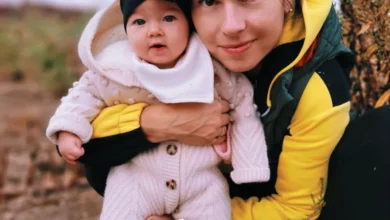The dark underbelly of Pakistan’s male body image revolution

In a small room in his modest family home, Asad Naqib Khan threads a sewing machine needle.
As the rhythmic hum of the machine fills the air, the tailor’s gaze occasionally drifts over to the screen of his mobile phone in the hand of his oldest child. The father and son are watching bodybuilding videos on YouTube.
Twenty-eight-year-old Asad is a father of five children aged 10 and younger. He is not just a tailor struggling to make ends meet — he is also an aspiring bodybuilder.
“For as long as I can remember, I have wanted to become a bodybuilder,” he explains while hemming a shirt that morning in early 2022. “I used to watch older guys in my neighbourhood go to the gym and spend time building their strength and muscles.” As a teenager, he fantasised about doing the same. “Once, I went to watch a bodybuilding competition and wanted to become just like the men I saw on the stage,” he recalls.
Asad grew up with eight siblings and remembers how his father, a daily wage labourer, would struggle to find regular work to support his family. As the eldest son, Asad felt compelled to share his father’s financial responsibilities as soon as he became a teenager. Leaving middle school meant he had limited options, but instead of opting to become a labourer like most men from his neighbourhood, he decided to apprentice with a tailor. When he was 18, he branched out on his own. Over the years, however, he yearned for the one thing he believed would bring purpose and happiness to his life – to become a professional bodybuilder. “One of my biggest dreams is to make Pakistan proud by competing internationally and winning for the country,” he explains.
But it wasn’t until 2019, when he met Zahir Shah, a former bodybuilding champion in his 40s who owns a gym in a busy Karachi neighbourhood, that Asad began on this path.
Asad finishes sewing the shirt and hands it to his son to fold. He says that his children, particularly the two boys, take delight in watching his workout videos. “They urge me to work out harder so I win first place. God willing, I will make them proud.”
He envisions introducing his sons to bodybuilding, and also has aspirations to open his own gym, like Zahir, which his boys can one day help him run “so I don’t have to work as a tailor any more.”
The growing global interest in fitness and bodybuilding culture has fuelled local interest in the sport with a surge in Pakistanis flocking to their local neighbourhood gyms.
Young men train tirelessly to showcase their physiques for competition judging panels through a series of poses to highlight muscle definition, size and symmetry.
Since Pakistan’s first championship was held in 1952, bodybuilding has remained largely a working-class pursuit – it is often referred to as a “poor man’s sport” within the community – and confined to small-scale regional and national competitions. But the sport has undergone a profound transformation in recent years owing to international exposure through social media, gaining wider attention and affording its star bodybuilders unprecedented opportunities. The prospect of participating in international championships, fame, cash prizes, travel, and potential modelling contracts has attracted thousands of men from Karachi to Peshawar and beyond. Aspiring bodybuilders with limited means spend their evenings after school or work fervently lifting weights beneath the glare of fluorescent gym lights and their coaches’ watchful eyes.
Many see bodybuilding as the first step out of poverty and dead-end jobs. Some are drawn to the allure of social media stardom as they post photos of their chiselled bodies online, while others dream of breaking into the modelling industry. Through interviews with bodybuilders and other industry insiders over reporting carried out between September 2021 and January 2024, we learn how men navigating the intersection of bodybuilding and modelling are exposed to worlds that both celebrate, and exploit, physical appearance.
The cost of bodybuilding
It is almost midnight, and the abandoned streets of a quiet residential colony lined with weathered concrete homes are lit with the dim glow of flickering streetlights. On the second floor of a small building, the lights of Zahir’s gym still burn brightly. Despite the late hour, the gym is packed and buzzing with energy, and old Bollywood songs blare from the speakers at each end of the stuffy room. Asad, and about two dozen other young men, are busy lifting weights. Their dedication to their training, according to Zahir, is often driven by the urge to conform to the archetypical male beauty standard set by global celebrities and influencers.
“Building a body that stands out costs more than most of these men earn,” Zahir explains.
The average monthly salary in Pakistan in 2023 was 81,925 rupees ($291) and most men entering the sport – either new graduates or unskilled workers – make significantly less. Balancing the responsibility of supporting their families amid Pakistan’s economic crisis with the financial demands of bodybuilding such as gym memberships, specialised diets, protein supplements, and professional coaching, is a huge challenge. Many bodybuilders end up borrowing money from friends or family, or taking out loans. Some become completely dependent on their coaches for support.
“I’ve been working as a tailor for over a decade, earning around 30,000 rupees ($107) per month,” says Asad, pausing after a set of bench presses. “Affording the essential protein-rich diet, which costs at least 1,000 rupees ($3.50) daily, is beyond my means.”
In fact, his entry into bodybuilding only became possible because Zahir waived his initial gym fees, offered complimentary training sessions, and occasionally assisted with his diet.
On the packed floor of his gym, Zahir watches the movements of his clients. “When Asad came to me he was like a matchstick,” he recalls fondly. “He is a very hard worker and one of my best students.”
Asad, who relies solely on the income generated from sewing shalwar-kameez, finds himself grappling with numerous financial responsibilities. It is a constant struggle to cover the children’s school fees, pay for nutritious food and meet other household costs. Even so, six or seven nights a week he rides his old bike across town to Zahir’s gym to spend the evening lifting weights.
“The coach helps me with whatever he can. I have even borrowed money from friends just so I can buy chicken and fish,” he admits, wiping sweat off his forehead as he gets ready for another set of repetitions.
“All the difficulties we face in reaching our goal are brought to fruition when we go out in public and people turn their heads to look at us,” another of Zahir’s trainees chimes in.
Zahir, who is a strong advocate for natural bodybuilding – training without the use of steroids, growth hormones, or diuretics – plays a pivotal role in Asad’s bodybuilding journey as he helps him prepare for competitions and foster discipline.
Asad confidently struts across the floor bare-chested, joking and engaging with others. “Even when I’m sewing clothes, my heart is here, in the gym,” he says with a big smile.
He is in no rush to go home, and says he will stay until 1 or 2am. It’s the kind of sport, he explains, where “the bigger you get, the smaller you feel you are, so you want to work harder to become even bigger.”
Gaining confidence
Across town, Usama Saeed, 30, a former bodybuilder who works as a fitness trainer at several gyms, wolfs down a homemade lunch of boiled rice and chicken inside a newly renovated air-conditioned Karachi gym. It’s almost 2pm, and his clients will soon start arriving for their daily training sessions.
Usama is well-built. He wears a snug white tank top, a silver chain glints against his skin and his gelled hair has new highlights. There is an authority in the way he effortlessly moves about the room, but, running a hand through his hair, he shyly admits that he has not always been this way.
He embarked on his bodybuilding journey after spending much of his teenage years in hospital receiving treatment for sarcoma, a rare bone and soft tissue cancer. “The cancer had left me physically frail, weighing a mere 42 kilos [93 pounds],” he explains, and that made him an easy target for bullying. “My own friends and cousins used to make fun of me because of my appearance.”










